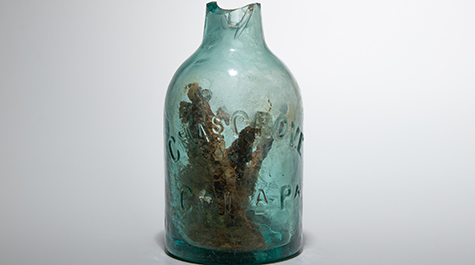Civil War-era bottle found on highway median may be rare ‘witch bottle’
At first glance, it just looked like a bottle full of junk.
“It was this glass bottle full of nails, broken, but all there, near an old brick hearth,” said Joe Jones, director of the William & Mary Center for Archaeological Research (WMCAR). “We thought it was unusual, but weren’t sure what it was.”
The bottle was recovered as part of an archaeological dig at the Civil War-era site of Redoubt 9, which today is more commonly known as exits 238 to 242 of I-64 in York County. The dig was conducted in 2016, in partnership with the Virginia Department of Transportation, and supervised by former WMCAR project archaeologist Chris Shephard, who now works for VDOT.
Jones notes that WMCAR works frequently and closely with VDOT, and the standard arrangement is for their archaeological work to be scheduled well in advance of active roadwork. In this case, the dig took place before VDOT’s planned interstate widening project.
What’s left of Redoubt 9 now rests in the median of Interstate 64. It was constructed by Confederates, but occupied by Union troops after the Battle of Williamsburg in 1862. The fortification was one of 14 mini-forts constructed along a line between the James and York rivers to counter the threat of a Federal assault on Richmond via the Peninsula, Jones explained.
“The Union troops were likely tasked with holding and repairing the fortification whenever they had reason to expect Confederate assault,” Jones said. “They were building up a fortification, so we just assumed they needed a place to keep their nails and used a bottle.”
The real use of the bottle, first suggested by WMCAR staff member Oliver Mueller-Heubach and WMCAR founder Robert Hunter, is far more interesting. Given the artifact’s contents and context, Mueller-Heubach and Hunter theorized, the nail-filled vessel is likely a rare ritual item known as a “witch bottle.”
Jones cited reports by historians indicating that the witch bottle tradition originated in the East Anglia region of England in the late Middle Ages and was introduced to North America by colonial immigrants.
The bottles served as a kind of talisman to ward off evil spirits, Jones explained. An afflicted person would bury the nail-filled bottle under or near their hearth, with the idea that the heat from the hearth would energize the nails into breaking a witch’s spell. While nearly 200 witch bottles have been documented in Great Britain, less than a dozen have been found in the United States.
“It’s a good example of how a singular artifact can speak volumes,” Jones said. “It’s really a time capsule representing the experience of Civil War troops, a window directly back into what these guys were going through occupying this fortification at this period in time.”
Records suggest that Redoubt 9 was occupied by the 5th Pennsylvania Cavalry intermittently between May 1862 and August 1863. The same regiment was held responsible for the burning of the Wren building. They likely occupied Redoubt 9 only during periods of strife, such as Confederate raids, when the Union hold on Williamsburg was at risk.
One such raid occurred on September 8, 1862, when a contingent of Virginia, Georgia and South Carolina cavalrymen attacked Union troops posted at William & Mary. The group went on to attack the Union camp and supply depot at Fort Magruder.
“Pennsylvania Cavalry would have occupied the outlying redoubts, including Redoubt 9, in the days and months following that raid in an attempt to keep Confederates from retaking them,” Jones said. “There were a lot of casualties and fear during this period. The Union troops were an occupying force in enemy territory throughout most of the war, so there were plenty of bad spirits and energy to ward off.”
Jones added that the nail-filled bottle found near a brick-lined encampment hearth was made by a bottler in Pennsylvania. That’s noteworthy, given the fortification was likely occupied by Pennsylvania cavalry.
Centuries later, there’s no way of knowing for sure if the artifact is a charm against evil spirits or just a bottle full of nails. Jones explained that most witch bottles contain relics of those who buried them. The afflicted would add nail clippings, locks of hair and even urine to witch bottles. The bottle recovered at Redoubt 9 was broken at the top, so Jones said it’s practically impossible to know who made it or what their real intentions were.
“Perhaps the nails in the bottle were put there not by enlisted men using the bottle as an expedient container, but instead by an officer who felt especially threatened occupying hostile territory,” Jones said. “Given the perceived threat of Confederate attack and general hostility of local residents, he had good reason to pull all the stops and rely on folk traditions from his community in Pennsylvania to help protect his temporary home away from home.”
















